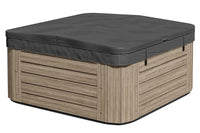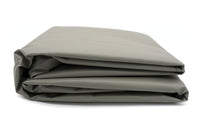Hot tubs are a luxurious addition to any home, providing relaxation and therapeutic benefits year-round. However, as the temperatures drop, your hot tub faces the risk of freezing if not properly cared for. Frozen water can cause significant damage, leading to costly repairs.
With a bit of preparation and the right approach, you can ensure your hot tub remains in perfect working order even in the coldest months. Follow these essential tips to keep your hot tub protected and running smoothly all winter long.
1. Invest in a High-Quality Winter Cover Cap
A winter cover cap is one of the most effective tools to shield your hot tub from the elements. This cover acts as a secondary layer of protection, insulating the tub and preventing heat from escaping. Not only does it help retain warmth, but it also keeps snow, debris, and ice from accumulating on the primary cover.
Why It Matters:
- Prevents freezing by trapping heat.
- Reduces the need for constant maintenance during heavy snowfall.
- Protects your main cover from wear and tear.
Make sure to pair your winter cover cap with deluxe hot tub covers for maximum insulation and durability.
2. Maintain Optimal Water Levels
Ensuring your hot tub has adequate water levels is crucial during winter. Low water levels can expose parts of the hot tub to freezing temperatures, causing pipes and jets to freeze. Regularly check your water levels and top up as needed.
Routine Tip:
- Perform routine winter hot tub maintenance to monitor water levels, chemical balance, and filter cleanliness.
- Always ensure that your water is circulating properly to avoid stagnant areas that may freeze.
3. Winterize Your Hot Tub If Not in Use
If you’re not planning to use your hot tub during the colder months, it’s essential to winterize your hot tub. This involves draining the water, cleaning the tub, and ensuring no moisture is left in the pipes to freeze.
Steps to Winterize:
- Drain all water from the tub.
- Use a wet/dry vacuum to clear water from pipes and jets.
- Clean and dry the interior thoroughly.
- Apply a winter cover cap for added protection.
Proper winterization can help protect your investment and save you from costly repairs down the road.
4. Keep Your Hot Tub Running for Year-Round Use
If you’re planning to enjoy your spa through the winter, ensure it’s set up for year-round hot tub use. Running your hot tub regularly during the colder months helps maintain its temperature and prevents freezing.
Benefits of Keeping It Running:
- Reduces the risk of frozen pipes and damage.
- Enjoy the benefits of hot tubbing in the winter, such as improved circulation and stress relief.
- Creates a cozy oasis for winter relaxation.
5. Insulate the Hot Tub Cabinet
The hot tub cabinet houses critical components like pumps and heaters. Adding insulation to this area can prevent heat loss and protect these parts from freezing temperatures. Check your cabinet for any gaps or worn-out seals and replace them if needed.
6. Monitor and Adjust the Temperature Regularly
To prevent freezing, ensure your hot tub’s water temperature is maintained at a minimum of 104°F (40°C). Many modern hot tubs have freeze protection settings that automatically activate the pump and heater when temperatures drop too low. Take advantage of these features to safeguard your spa.
7. Schedule Regular Maintenance
Winter maintenance doesn’t stop once your hot tub is set up. Regular check-ins will help you spot issues like clogged filters or slow pumps before they escalate into larger problems.
- Clean filters to ensure proper water circulation.
- Check for leaks and fix them immediately.
- Perform a monthly water balance test to prevent scaling or corrosion.
8. Prepare for Power Outages
Winter storms can cause unexpected power outages, leaving your hot tub vulnerable to freezing. To prepare:
- Keep a generator or backup power source on hand.
- Use thermal blankets over the water to retain heat temporarily.
- Drain your hot tub if an extended power outage is expected.
9. Enjoy the Benefits of Winter Hot Tubbing
Hot tubbing in winter isn’t just about avoiding frozen pipes; it’s also an opportunity to unwind and reap health benefits. From improved circulation to stress relief, the benefits of hot tubbing in the winter are endless.
10. Use a Thermal Blanket for Extra Heat Retention
Adding a thermal blanket to your hot tub is a simple yet effective way to retain heat and protect against freezing temperatures. A thermal blanket floats on the surface of the water, creating an additional layer of insulation to minimize heat loss.
Benefits of a Thermal Blanket:
- Improves Energy Efficiency: By trapping heat, a thermal blanket reduces the energy required to maintain your hot tub’s temperature, which can lead to lower utility bills.
- Prevents Water Evaporation: During the colder months, water evaporation can lead to heat loss and increased strain on your heating system. A thermal blanket minimizes this issue.
- Protects Against Debris: While primarily for heat retention, a thermal blanket can also act as a barrier against dust, leaves, and other debris that might find their way into your hot tub.
Pro Tips for Using a Thermal Blanket:
- Choose a blanket made from high-quality, durable foam or bubble material specifically designed for hot tubs.
- Cut the blanket to match the exact dimensions of your tub for maximum coverage.
- Use the thermal blanket in conjunction with a winter cover cap for double the insulation and protection.
11. Regularly Inspect Your Hot Tub’s Components
Winter can be particularly tough on the internal components of your hot tub, making regular inspections critical to prevent potential issues from escalating into costly repairs. A few extra minutes spent checking your hot tub's key parts can save you both time and money in the long run.
What to Inspect:
- Jets and Filters: Ensure that all jets are functioning properly and that filters are clean and free of debris. Dirty or clogged filters can restrict water circulation, increasing the risk of freezing.
- Pipes and Connections: Look for any signs of leaks, cracks, or weak spots in the pipes and connections. Even a small leak can worsen under freezing conditions, potentially leading to burst pipes.
- Pump and Heater: Make sure the pump and heater are working efficiently. Unusual noises, inconsistent heating, or reduced water flow could indicate problems that need immediate attention.
Tips for Effective Inspections:
- Conduct a visual inspection weekly during colder months.
- Run a test cycle to ensure all components, including circulation and heating systems, are operating smoothly.
- Keep a maintenance log to track any recurring issues and address them proactively.
12. Enhance Surrounding Area Insulation
While insulating your hot tub itself is essential, paying attention to the surrounding area can significantly improve its efficiency and protect it from freezing temperatures. Creating a warmer environment around your spa can reduce heat loss and minimize strain on your hot tub’s heating system.
Ways to Insulate the Surrounding Area:
- Wind Barriers: Install windbreaks such as fences, shrubs, or privacy panels around your hot tub to block cold winds from reaching the spa. This simple measure can help maintain a stable temperature.
- Outdoor Enclosures: Consider setting up a gazebo or partial enclosure around your hot tub. These structures not only offer protection from snow and wind but also create a cozy, private space for winter relaxation.
- Thermal Mats: Place thermal mats or insulated flooring underneath your hot tub to prevent heat loss through the ground. These mats act as a barrier against cold surfaces, keeping the water temperature steady.
Bonus Tip:
Adding ambient features like outdoor heaters or heated pathways around your hot tub can make it more enjoyable to use during the winter. Plus, a well-insulated area can extend the lifespan of your spa by reducing wear on its components.
Enhancing the insulation of your hot tub’s surrounding area ensures that it remains an inviting and functional space, even during the harshest winter weather.
13. Use Smart Technology to Monitor Your Hot Tub
Incorporating smart technology into your hot tub maintenance routine can help you monitor and protect it with ease, especially during the colder months. With modern advancements, you can keep tabs on your spa's performance and temperature remotely, ensuring it stays in optimal condition.
Benefits of Smart Technology:
- Real-Time Alerts: Receive notifications on your phone if the water temperature drops below a safe level or if there's a malfunction in the system.
- Remote Control: Adjust settings such as temperature, filtration cycles, or freeze protection from anywhere, giving you peace of mind during vacations or extended absences.
- Energy Efficiency: Smart systems can optimize energy use by monitoring the environment and adjusting heating or circulation cycles accordingly.
Examples of Smart Features:
- Smart hot tub monitors with built-in sensors for temperature and water flow.
- Wi-Fi-enabled controllers that allow you to manage your spa from a mobile app.
- Integration with smart home systems like Alexa or Google Assistant for voice-activated controls.
Final Thoughts
By following these tips, you can ensure your hot tub remains in top condition throughout the winter season. Whether you’re gearing up for year-round hot tub use or planning to winterize your hot tub, investing in proper protection and regular maintenance will not only keep your spa safe but also enhance your winter relaxation experience.









